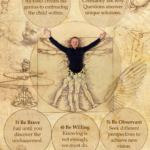We hear it frequently.
The coaching client says, “But I’m just not creative”.
Yet your ability to unleash your creative mind is a huge driver in the success of your territory…and your career.
As a former advertising executive on Madison Ave, Scott knows that creativity is more than an art, it’s a skill. His skills have placed him on some of New York City’s most prominent improv comedy stages, and his paintings on some of the most prestigious gallery walls. He knows how to perform, both as a television host on the Travel Channel, as well as the first white guy on Soul Train.
Scott now talks and trains with his program UNLEASH YOUR INNER DA VINCI™. Using a revolutionized model that draws knowledge and wisdom from rarely told stories of Leonardo da Vinci, personal experiences, fast painting, and improvisation, Scott delves into Creativity, Innovation, Productivity, Perspective, and Team Building to create a unique and all-encompassing experience.
So why is creativity so important?
Here is an excerpt from an article on FastCompany: “Creativity is now the most important leadership quality for success in business, outweighing even integrity and global thinking.” Creative leaders are more prepared to break with the status quo of industry, enterprise and revenue models, and they are 81% more likely to rate innovation as a “crucial capability.” There is a war on talent, and thinking creatively makes you more valuable.
Here Are 5 Ways History’s Most Innovative Person Used Creative Thinking
1. Be Childlike. Everyone has the ability to be creative.
Leonardo said the secret to his amazing creativity was that he remained “child-like”. Most people are born with curiosity and imaginative impulses. However, as they reach adulthood, they are taught to stifle that creative energy in favor of more realistic and traditional thinking.
The downfall of this sort of thinking is that when we limit creativity, we also greatly limit the solutions at hand, as well as their rates of success. The good news is that the childlike creativity and curiosity still exists within all of us, and the challenge lies only in reopening the door to our inner child and allowing those creative threads to lead us to plausible solutions within a business environment.
2. Be Curious. What question has led to more innovation than any other?
What is the question most often asked by children?
Why.
Modern researchers that have studied da Vinci’s brilliance say it was the result of relentlessly asked questions. His hundreds of notebooks are filled with questions and observations, not answers. A popular question asked by children is, “How do birds fly?” This was da Vinci’s most insatiable question. He observed birds with intense awareness and then questioned what it would take for man to fly, hundreds of years before it was made a reality.
Many times, we are afraid to ask why, thinking it may make us look dumb. How dumb did it make Leonardo look?
3. Be Brave. Don’t be afraid to look like a fool; show your vulnerability.
“Life is pretty simple: You do some stuff. Most fails. Some works.” – Leonardo da Vinci.
Not everyone knows this, but vulnerability is often a precursor to possibility. Fear of expressing oneself openly and fully shuts oneself off to wild possibility and innovation. Thanks to abandoning the preconceived notions Scott had about himself, and following those desires fearlessly, he became “the first white guy” on SoulTrain, a story people still want to hear about years later.
Being afraid to do or say something that has never been done is the greatest enemy of creativity. Be fearless.
4. Be Willing. Creative breakthroughs occur in a “Yes And” environment.
We have all been in the opposite of a “Yes And” meeting, “The NO BUT,” meeting. The meetings where everyone is tasked to come up with “the Big Idea”, but every creative idea is shot down without consideration and negativity is bred. Thus, the meeting just withers and dies.
Creative breakthroughs happen in an environment where ideas are fully explored, heightened, and stretched to levels beyond imagination.
This is the goal of the Yes And rule.
5. Be Observant. Always seek a different perspective.
We severely limit ourselves when we continually look at things- projects, problems, art pieces- from the same perspective that we have always done. Switch it up, literally move and look at it from another viewpoint, flip it on its head and examine it from a different angle, ask someone with an outside or indifferent eye.
Too many of us don’t step back and evaluate our solutions. We have our noses pressed up to our issues and get absorbed by the details. Then when you finally take a step back and look at your problem from a fresh perspective, you’re lost. Give yourself an opportunity to evaluate your solutions from a different place.
By applying these 5 principles of da Vinci to creative thinking to your everyday life, you will not only begin to unlock your ability to craft more unique solutions, but you will also become a more valuable team member, be more successful in personal business ventures, and most importantly, live a happier life.
Written by Scott Shellstrom



 Great Wholesalers Give More in Value Than They Receive with Bob Burg
Great Wholesalers Give More in Value Than They Receive with Bob Burg On My Mind: How Great Wholesalers Handle the Coronavirus Event and the Market Meltdown
On My Mind: How Great Wholesalers Handle the Coronavirus Event and the Market Meltdown You Might Be The Best, But You Can Still Be Better with Mark Sanborn
You Might Be The Best, But You Can Still Be Better with Mark Sanborn Proven Ways Wholesalers Increase Their Likeability Factor with Cam Marston
Proven Ways Wholesalers Increase Their Likeability Factor with Cam Marston The Convergence of Health Care and Financial Planning with Peter Stahl
The Convergence of Health Care and Financial Planning with Peter Stahl